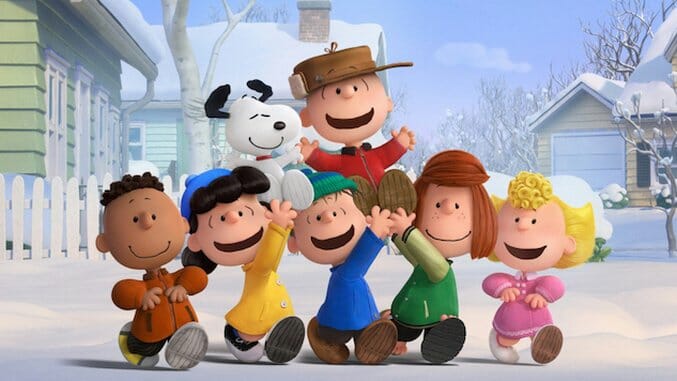The Peanuts Movie

The key to enjoying The Peanuts Movie is tempered expectations. When Charles Schulz’s milestone comic strip first premiered in the papers back in October of 1950, nobody could have possibly predicted the meteoric impact his work would have on both his medium and on popular culture at large. Calling Peanuts “influential” doesn’t quite cut it: Schulz’s comic is the once-in-a-lifetime kind of pop art that shapes genres and generations alike. Can The Peanuts Movie live up to that level of reputation? For many, Peanuts’ massive success and long-lasting legacy will loom over The Peanuts Movie like the shadow of the kite-eating tree, but the good news is they don’t have to.
Like father, like sons. The Peanuts Movie is the imaginative product of Charles, his son Craig, and Craig’s son Bryan, the latter two of whom helped write the film’s screenplay with scribe Cornelius Uliano. For their ringmaster they’ve chosen Steve Martino, co-director on two previous Blue Sky Studios efforts, 2008’s Horton Hears a Who! and 2012’s Ice Age: Continental Drift. That reads like a recipe for middle-of-the-road children’s fare: Blue Sky makes adequate movies with adequate flair, seasoned just enough to stave off blandness and hold a theater full of kids in their thrall and give their parents 90 minutes’ respite.
Somehow, The Peanuts Movie adds up to more than just distraction. Maybe it’s the involvement of the Schulzes, who have demonstrable skin in the Peanuts adaptation game. Maybe it’s Charles himself, who infused his characters with such immensity of spirit that they’ve spoken meaningfully to audiences for 65 years. Either way, The Peanuts Movie works, not just as a yarn about Charlie Brown and his bungling attempts to win the love of the nameless, redheaded new girl in his class, but as an example of 3D animation that defies its own boundaries. Yes, the film hews close to convention by lazily hucking random objects at the screen to dazzle viewers with minimal effort. But when it’s not busy staging obvious 3D-dependent sight gags, it’s focused on making the 3D look 2D. The visuals have texture. The characters move and emote with a snappiness that reads more like cell-shaded animation than 3D animation. Snoopy’s flights of fancy, where he engages in dogfights with the Red Baron, are every bit as spectacular as the most high-budget summer tent pole fare.
-

-

-

-

-

-

-

-

-

-

-

-

-

-

-

-

-

-

-

-

-

-

-

-

-

-

-

-

-

-

-

-

-

-

-

-

-

-

-

-








































